当前位置:网站首页>MySQL advanced index [classification, performance analysis, use, design principles]
MySQL advanced index [classification, performance analysis, use, design principles]
2022-04-23 17:38:00 【Everything will always return to plain】
Catalog
4.1 Clustered index & Secondary indexes
5.1 SQL Frequency of execution
6.7 Single column index and joint index
Indexes (index) Help MySQL Data structure for efficient data acquisition ( Orderly ).
Out of data , The database system also maintains a data structure that satisfies a specific search algorithm , These data structures are referenced in some way ( Point to ) data , In this way, advanced search algorithms can be implemented on these data structures , This data structure is the index .
An index is like a catalogue of books , We can quickly find the chapter we want to read through the catalogue , You don't have to look through pages .
1、 demonstration
The table structure and its data are as follows :
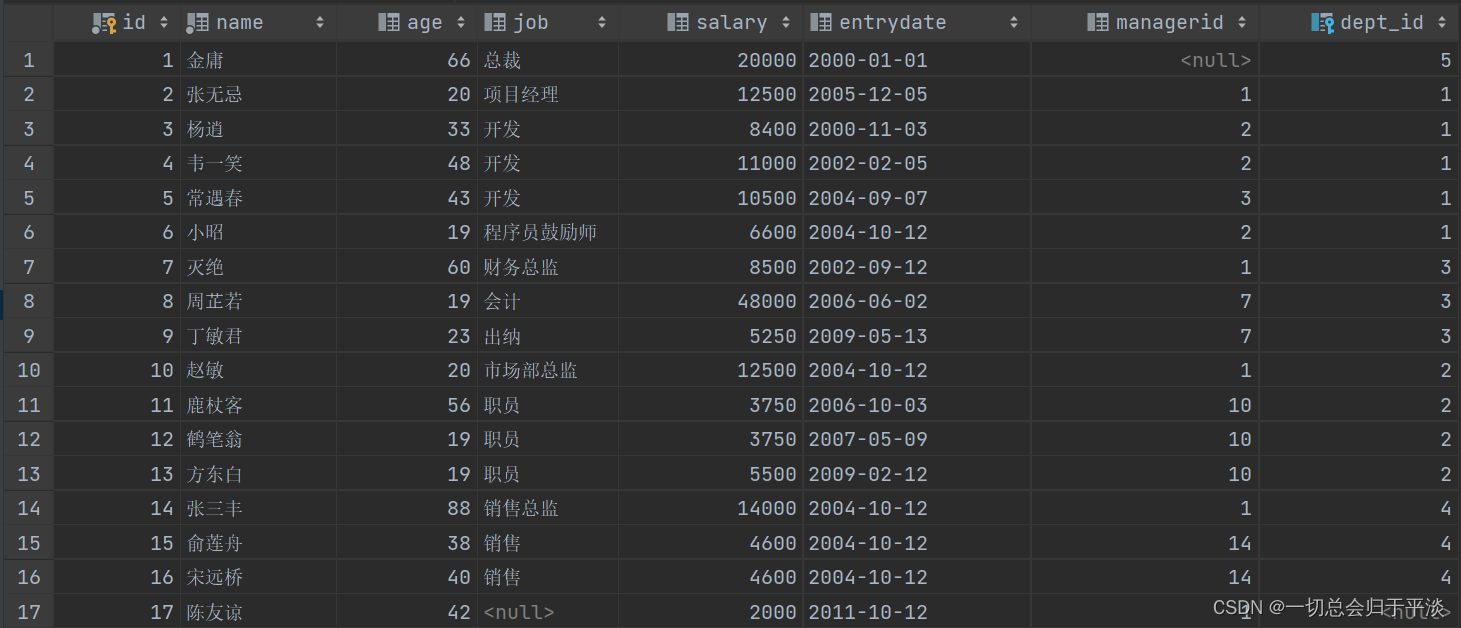
If we want to implement SQL Statement for : select * from user where age = 42;
1.1、 No index
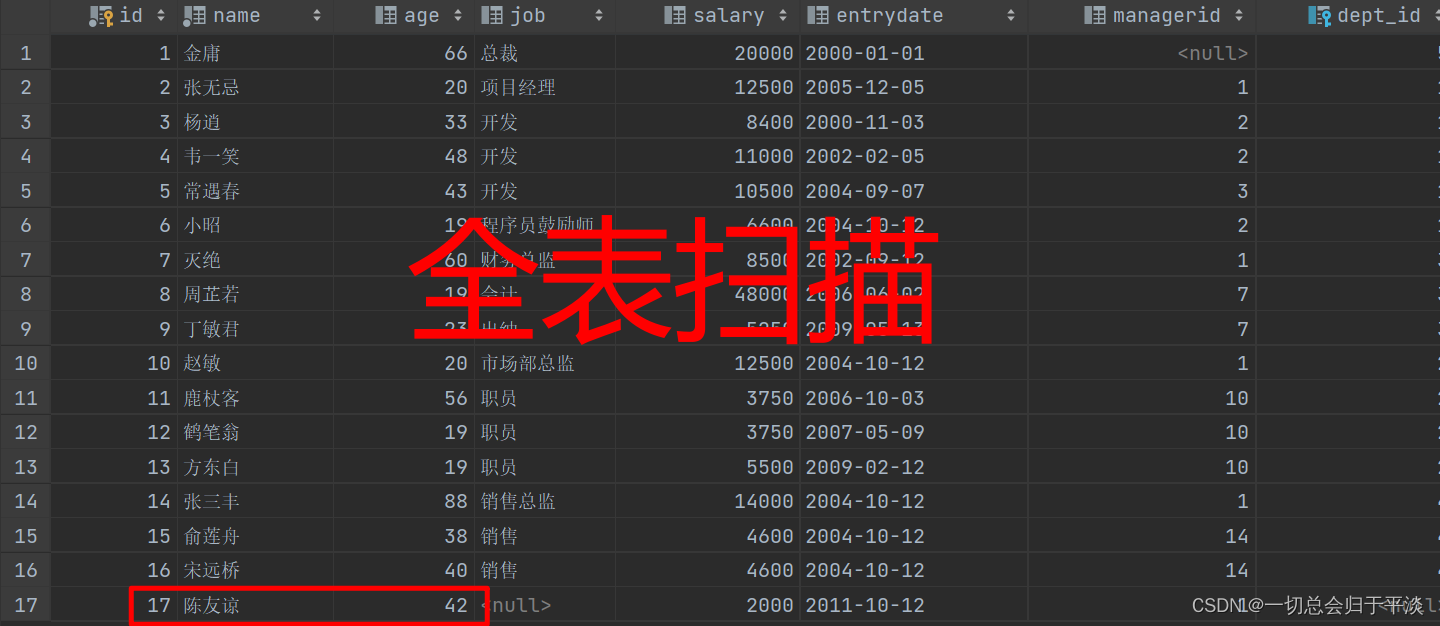
Without index , You need to scan from the first line , Scan until the last line , We call it Full table scan , Very good performance low .
1.2、 When there is an index
If we index this table , Suppose the index structure is a binary tree , So it means , Would be right age This field establishes a binary tree index structure .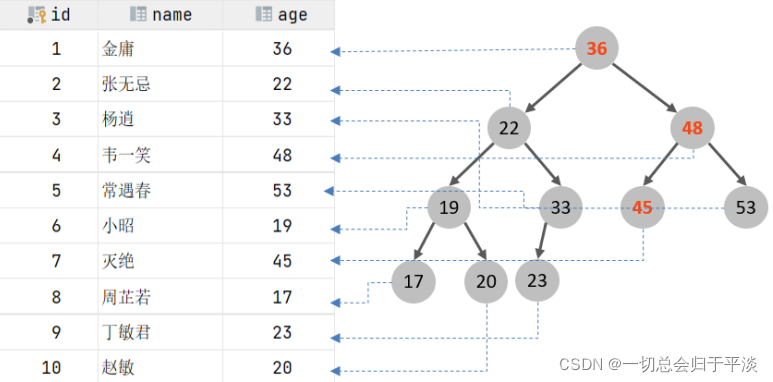
At this point, when we query , It only takes a few scans to find the data , Greatly improve the efficiency of query
notes :
Here we just assume that the structure of the index is a binary tree , Introduce the general principle of index , It's just a sketch , and
Not the real structure of the index .
2、 characteristic
advantage :
Improve the efficiency of data retrieval , Reduce the IO cost .
Sort data through index columns , Reduce the cost of sorting data , Reduce CPU Consumption of .
Inferiority :
Index columns also take up space .
Indexing greatly improves query efficiency , At the same time, it also reduces the speed of updating tables , Such as on the table INSERT、UPDATE、DELETE when , Low efficiency .
3、 Index structure
MySQL The index of is implemented in the storage engine layer , Different storage engines have different index structures , It mainly includes the following :
B+Tree Indexes : The most common type of index , Most engines support B+ Tree index .
Hash Indexes : The underlying data structure is realized by hash table , Only the exact index matches the columns , Range query is not supported .
R-tree( Spatial index ) : The spatial index is MyISAM A special index type of the engine , Mainly used for geospatial data types , Usually used less .
Full-text( Full-text index ): It's a way of building inverted indexes , How to quickly match documents . Be similar to Lucene,Solr,ES .
The above is MySQL All index structures supported in , Next , Let's take a look at the support of different storage engines for index structure .
| Indexes | InnoDB | MyISAM | Memory |
|---|---|---|---|
| B+tree Indexes | Support | Support | Support |
| Hash Indexes | I won't support it | I won't support it | Support |
| R-tree Indexes | I won't support it | Support | I won't support it |
| Full-text | 5.6 Support for | Support | I won't support it |
Be careful : What we usually call index , If not specified , All refer to B+ Index of tree structure organization .
3.1 Binary tree
If say MySQL The index structure of adopts the data structure of binary tree , The ideal structure is as follows :
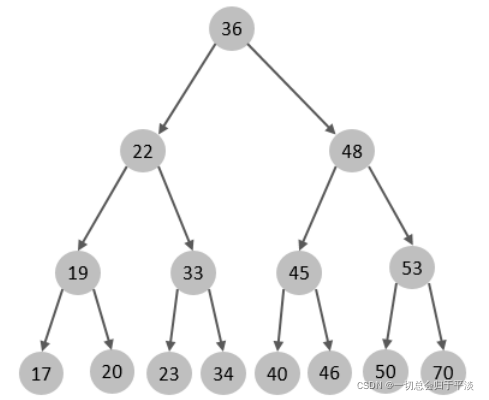
If the primary key is inserted sequentially , Will form a one-way linked list , The structure is as follows
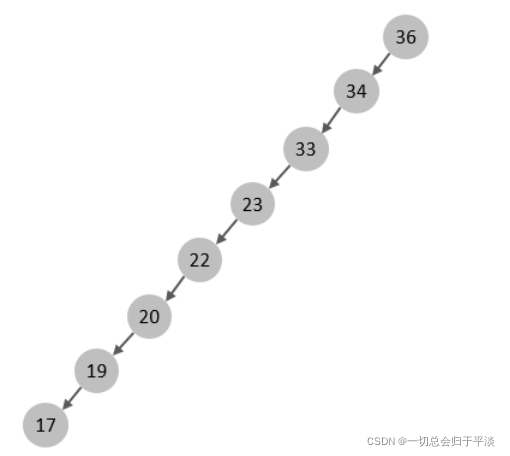
therefore , If you choose a binary tree as the index structure , There will be the following disadvantages :
On sequential insertion , It will form a linked list , Query performance is greatly reduced .
In case of large amount of data , Deeper levels , The retrieval speed is slow .
At this point, you may think , We can choose red and black trees , Red black tree is a self balanced binary tree , So even if it's sequential insertion According to the , The resulting data structure is also a balanced binary tree , The structure is as follows :
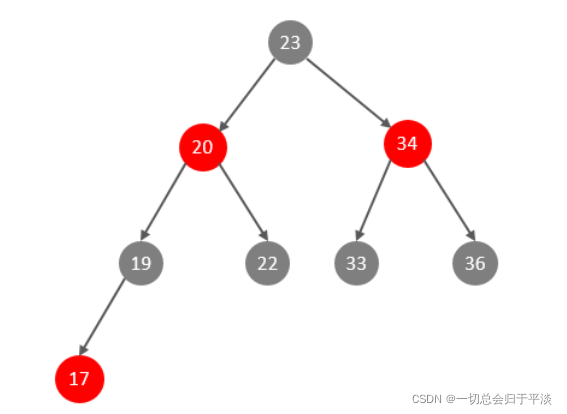
however , Even so , Because the red black tree is also a binary tree , So there will be a disadvantage :
-
In case of large amount of data , Deeper levels , The retrieval speed is slow .
therefore , stay MySQL In the index structure of , Did not choose binary tree or red black tree , And the choice is B+Tree, So what is B+Tree Well ?
3.2 B-Tree
B-Tree,B A tree is a kind of multi fork road scale search tree , Relative to a binary tree ,B Each node of the tree can have multiple branches , That is, multi fork .
At a maximum degree (max-degree) by 5(5 rank ) Of b-tree For example , So this one B Each node of the tree can store up to 4 individual key,5 A pointer to the :
notes :
The degree of a tree refers to the number of child nodes of a node .
characteristic :
5 Step B Trees , Each node can store up to 4 individual key, Corresponding 5 A pointer to the .
Once the node stores key The quantity has arrived 5, Will fission , The intermediate element splits up .
stay B In the tree , Both non leaf nodes and leaf nodes store data .
3.3 B+Tree
B+Tree yes B-Tree Variants , We have a maximum degree (max-degree) by 4(4 rank ) Of b+tree For example , Let's take a look at its structural diagram :
We can see , Two parts :
-
The green framed part , It's the index part , It only plays the role of indexing data , Don't store data .
-
The part framed in red , It's the data storage part , Specific data should be stored in its leaf node .
characteristic :
All the data will appear in the leaf node .
Leaf nodes form a one-way linked list .
Non leaf nodes only serve to index data , The specific data is stored in the leaf node .
The structure we see above is standard B+Tree Data structure of , Next , Let's see MySQL After optimization in B+Tree.
MySQL Index data structure for classic B+Tree optimized .
In the original B+Tree On the basis of , Add a pointer to the linked list of adjacent leaf nodes , So we have a sequence pointer B+Tree, Improve the performance of interval access , Conducive to sorting .
3.4 Hash
Hash index is to use a certain hash Algorithm , Convert key values to new hash value , Map to the corresponding slot , Then stored in hash In the table .
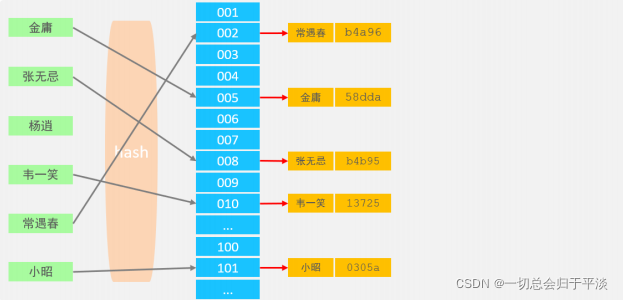
If two ( Or more ) Key value , Map to the same slot , They produced hash Conflict ( Also known as hash Collision ), can To solve the problem through a linked list .
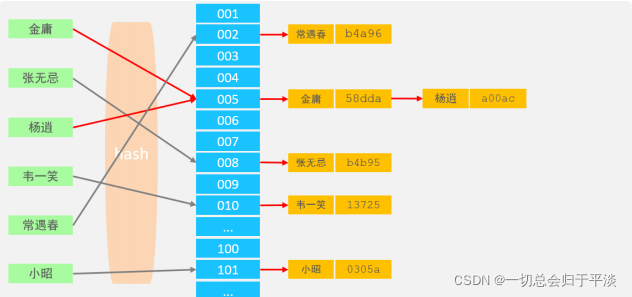
characteristic :
Hash Indexes can only be used for peer-to-peer comparisons (=,in), Range query is not supported (between,>,< ,...) .
Cannot complete sort operation with index .
High query efficiency , Usually ( non-existent hash Conflict situation ) It only needs one search , Efficiency is usually higher than B+tree Cable lead .
stay MySQL in , Support hash The index is Memory Storage engine .
and InnoDB It has adaptive function hash function ,hash The index is InnoDB The storage engine is based on B+Tree The index is automatically built under specified conditions .
Interview questions :
Why? InnoDB The storage engine chooses to use B+tree Index structure ?
answer :
Relative to a binary tree , Fewer levels , High search efficiency ;
about B-tree, Whether leaf nodes or non leaf nodes , Data will be saved , This results in fewer key values stored in a page , The pointer decreases , Save a lot of data as well , Can only increase the height of the tree , Resulting in reduced performance ;
relative Hash Indexes ,B+tree Support range matching and sorting operations ;
4、 Index classification
stay MySQL database , The specific types of indexes are mainly divided into the following categories :
primary key 、 unique index 、 General index 、 Full-text index .
| classification | meaning | characteristic | keyword |
|---|---|---|---|
| Primary key Indexes | The index created for the primary key in the table | Automatically created by default , Can only There is one | PRIMARY |
| only Indexes | Avoid duplicate values in a data column in the same table | There can be multiple | UNIQUE |
| General index | Quickly locate specific data | There can be multiple | |
| Full-text index | The full-text index looks up the keywords in the text , Not more than Compare the value in the index | There can be multiple | FULLTEXT |
4.1 Clustered index & Secondary indexes
And in the InnoDB In the storage engine , According to the storage form of the index , It can be divided into the following two types :
| classification | meaning | characteristic |
|---|---|---|
| Clustered index (ClusteredIndex) | Put data storage and index together , The leaf node of the index structure holds the row data | There has to be , And only There is one |
| Secondary indexes (SecondaryIndex) | Separate data from index , The leaf node of the index structure is associated with the corresponding primary key | There can be multiple |
Clustered index selection rules :
If there is a primary key , A primary key index is a clustered index .
If there is no primary key , The first unique... Will be used (UNIQUE) Index as clustered index .
If the table does not have a primary key , Or there is no suitable unique index , be InnoDB It will automatically generate a rowid As a hidden clustered index .
The specific structures of clustered index and secondary index are as follows :
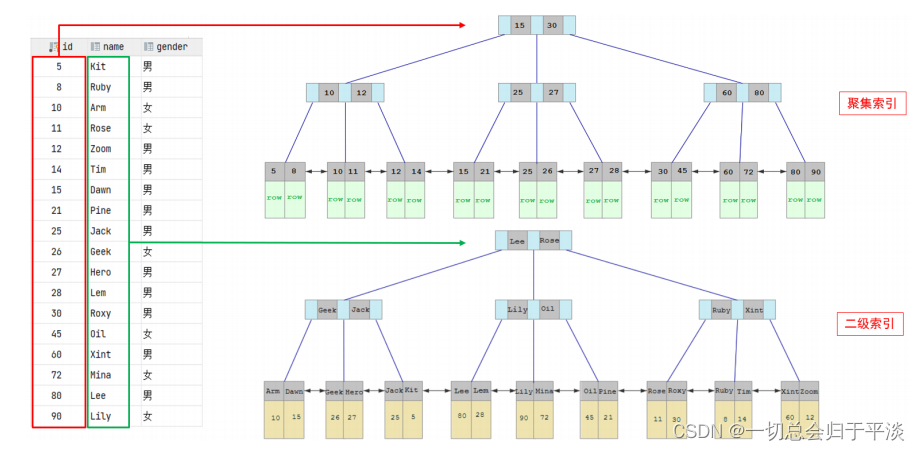
The data of this row is hung under the leaf node of the clustered index .
The primary key value corresponding to the field value is hung under the leaf node of the secondary index .
When we execute the following SQL When the sentence is , What is the specific search process like .
select *
from emp
where name = ' Jin yong 'The process is as follows :
1、 Because it's based on name Field to query , So first according to name=' Jin yong ' To name Field in the secondary index . But in the secondary index, you can only find Jin yong The corresponding primary key value 1.
2、 Because the data returned by the query is *, So at this time , You also need to use the primary key value 1, Find in the clustered index 1 Corresponding records , Finally find 1 The corresponding line row.
3、 Finally get the data of this line , Just go back .
Return to the table for query :
This first to look up data in the secondary index , Find primary key value , Then it is added to the clustered index according to the primary key value , obtain
The way of data , It is called back to table query .
Thinking questions :
Here are two SQL sentence , The execution efficiency is high ? Why? ?
1、 select * from emp where id = 1 ;
2、select * from user where name = ' Jin yong ' ;
remarks : id Primary key ,name Fields are indexed ;
4.2 Index Syntax
1、 Create index
CREATE [ UNIQUE | FULLTEXT ] INDEX index_name ON table_name (index_col_name,... ) ;2、 Look at the index
SHOW INDEX FROM table_name ;3、 Delete index
DROP INDEX index_name ON table_name ; 15、SQL Performance analysis
5.1 SQL Frequency of execution
MySQL After successful client connection , adopt show [session|global] status Command can provide server status information .
By the following instructions , You can view the INSERT、UPDATE、DELETE、SELECT Frequency of visits :
notes :
1、session Is to view the current session ;
2、global Global query is data ;
SHOW GLOBAL STATUS LIKE 'Com_______'; 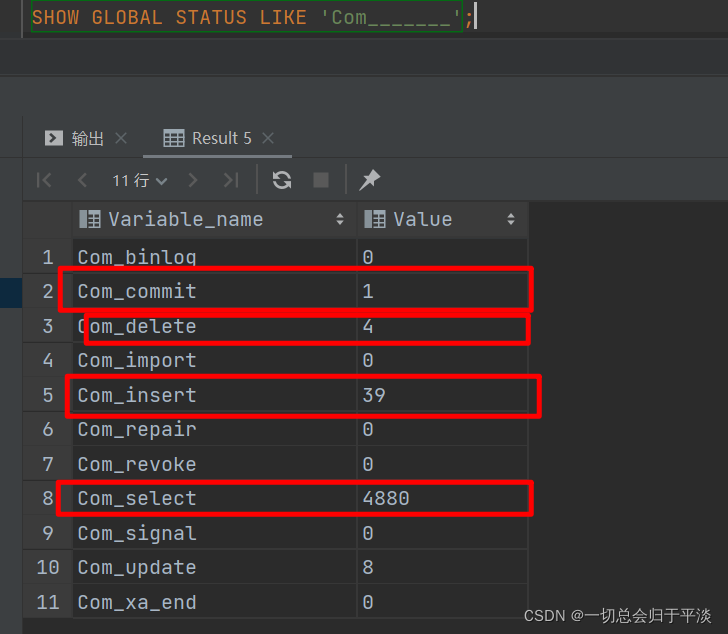
Com_delete: Number of deletions
Com_insert: Number of inserts
Com_select: Query times
Com_update: Number of updates
Through the above instructions , We can see whether the current database is based on query , Or mainly add, delete and modify , So as to provide data
Provide reference basis for library optimization .
If it is mainly based on addition, deletion and modification , We can consider not optimizing the index . If it is based on query , Then we should consider optimizing the index of the database .
Then through the query SQL Frequency of execution of , We can know whether the current database is mainly for addition, deletion and modification , Or mainly query . That fake For example, it is mainly based on query , How can we optimize those query statements ?
The number of times we can use the slow query log .
5.2 Slow query log
The slow query log records all execution times that exceed the specified parameters (long_query_time, Company : second , Default 10 second ) All of the SQL Statement log .
MySQL The slow query log is not enabled by default , We can look at the system variables slow_query_log.
SHOW variables like 'slow_query_log';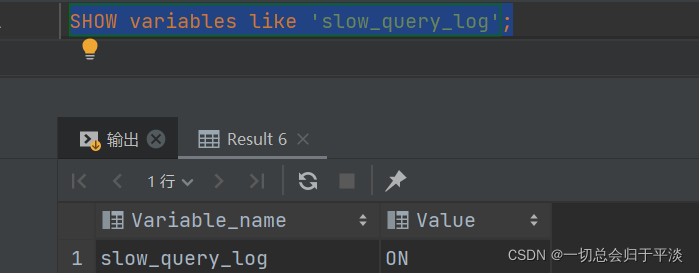
If you don't turn it on , Need to be in MySQL Configuration file for (/etc/my.cnf) The following information is configured in :
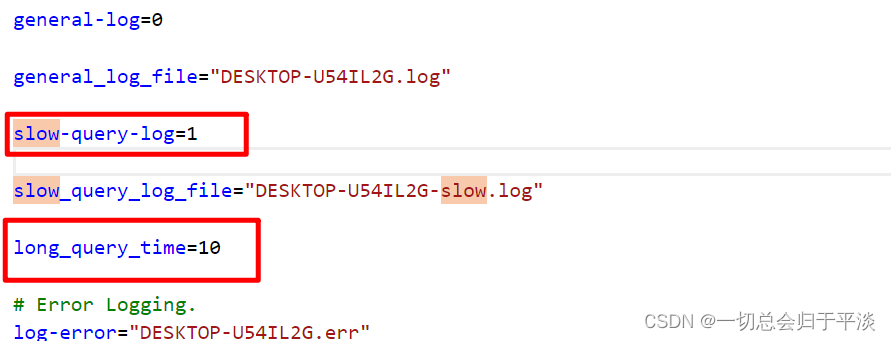
notes :
If you don't find the location provided above my.cnf, You can go to C:\ProgramData\MySQL\MySQL Server 8.0 look for my.ini, That's what I am .
The first red box is to open MySQL Slow log query switch , The second is to set the time of slow log to 2 second ,SQL Statement execution time exceeds 2 second , It will be regarded as slow query , Log slow queries .
Once configured , Restart... With the following command MySQL The server tests .
systemctl restart mysqldtest :
The implementation is as follows SQL sentence :
No data is inserted now :
select * from tb_user; Insert this time 100w Data , Query again
select count(*) from tb_sku;
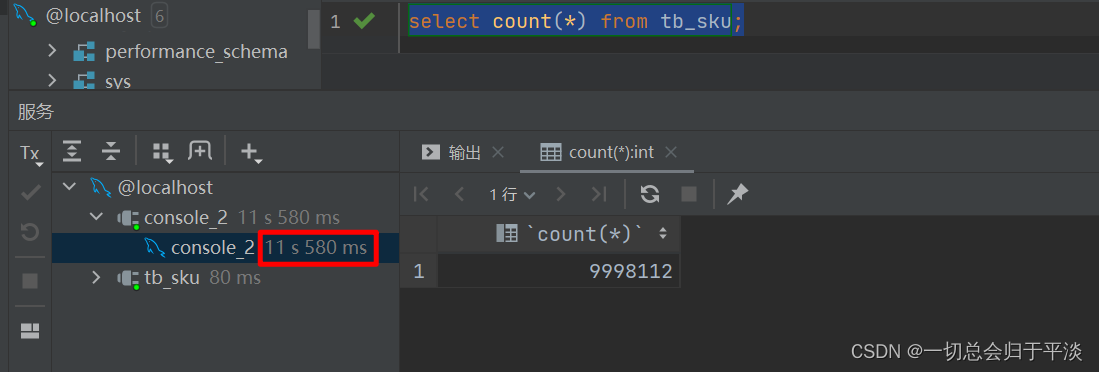
Check the slow query log :
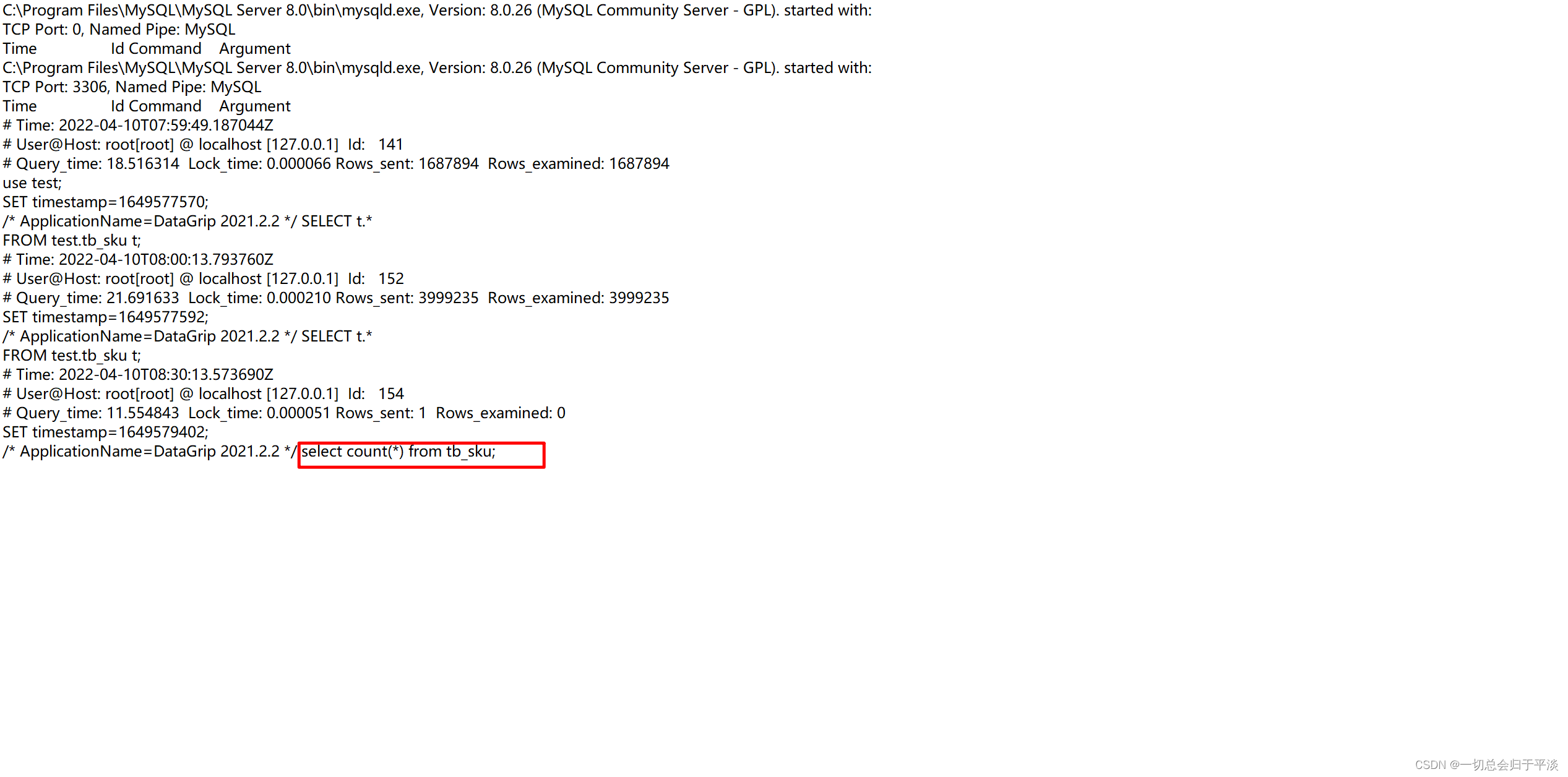
In the end, we found out , In slow query log , Only the execution time will be recorded, which exceeds our preset time (10s) Of SQL, Perform faster SQL It won't be recorded .
That such , Log by slow query , We can locate those with low execution efficiency SQL, Thus targeted optimization .
5.3 profile details
show profiles Be able to do SQL Optimization helps us understand where the time is spent .
adopt have_profiling Parameters , Be able to see the present MySQL Do you support profile operation :
SELECT @@have_profiling ;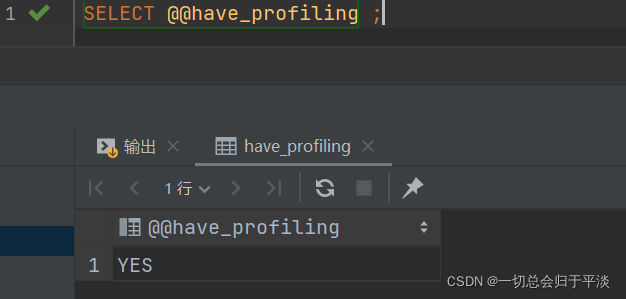
You can see , At present MySQL It's supporting profile Operation of the , If the switch is off . Can pass set Statements in
session/global Level on profiling:
SET [session/global] profiling = 1;The switch has been turned on , Next , What we do SQL sentence , Will be MySQL Record , And record where the execution time is spent .
We directly execute the following SQL sentence :
select * from tb_user;
select * from tb_user where id = 1;
select * from tb_user where name = ' White ';
select count(*) from tb_sku;Execute a series of business SQL The operation of , Then check the execution time of the instruction through the following instructions :
1、 Check each one SQL The time-consuming basic situation of
show profiles;2、 View specified query_id Of SQL The time-consuming situation of each stage of the statement
show profile for query query_id;3、 View specified query_id Of SQL sentence CPU Usage situation
show profile cpu for query query_id; Check each one SQL Time consuming :
View specified SQL The time-consuming situation of each stage :
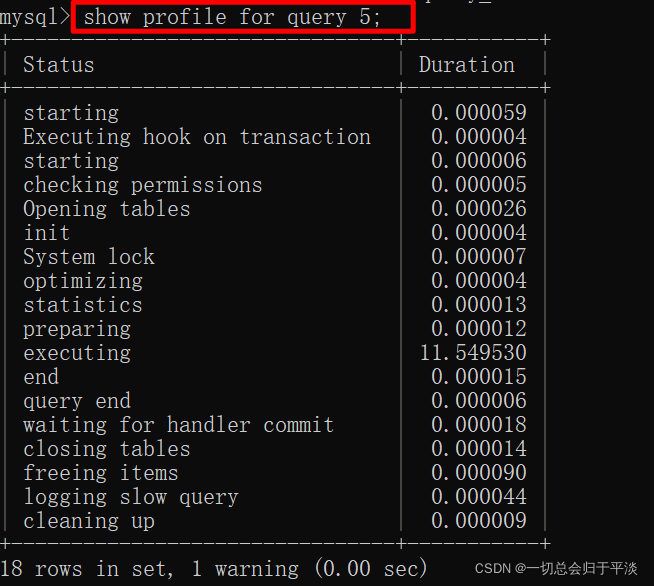
5.4 explain
EXPLAIN perhaps DESC Command acquisition MySQL How to execute SELECT Statement information , Included in SELECT How tables are joined and the order in which they are joined during statement execution .
grammar :
Directly in select Add the keyword before the statement explain / desc
EXPLAIN SELECT Field list FROM Table name WHERE Conditions ;
Explain The meaning of each field in the execution plan :
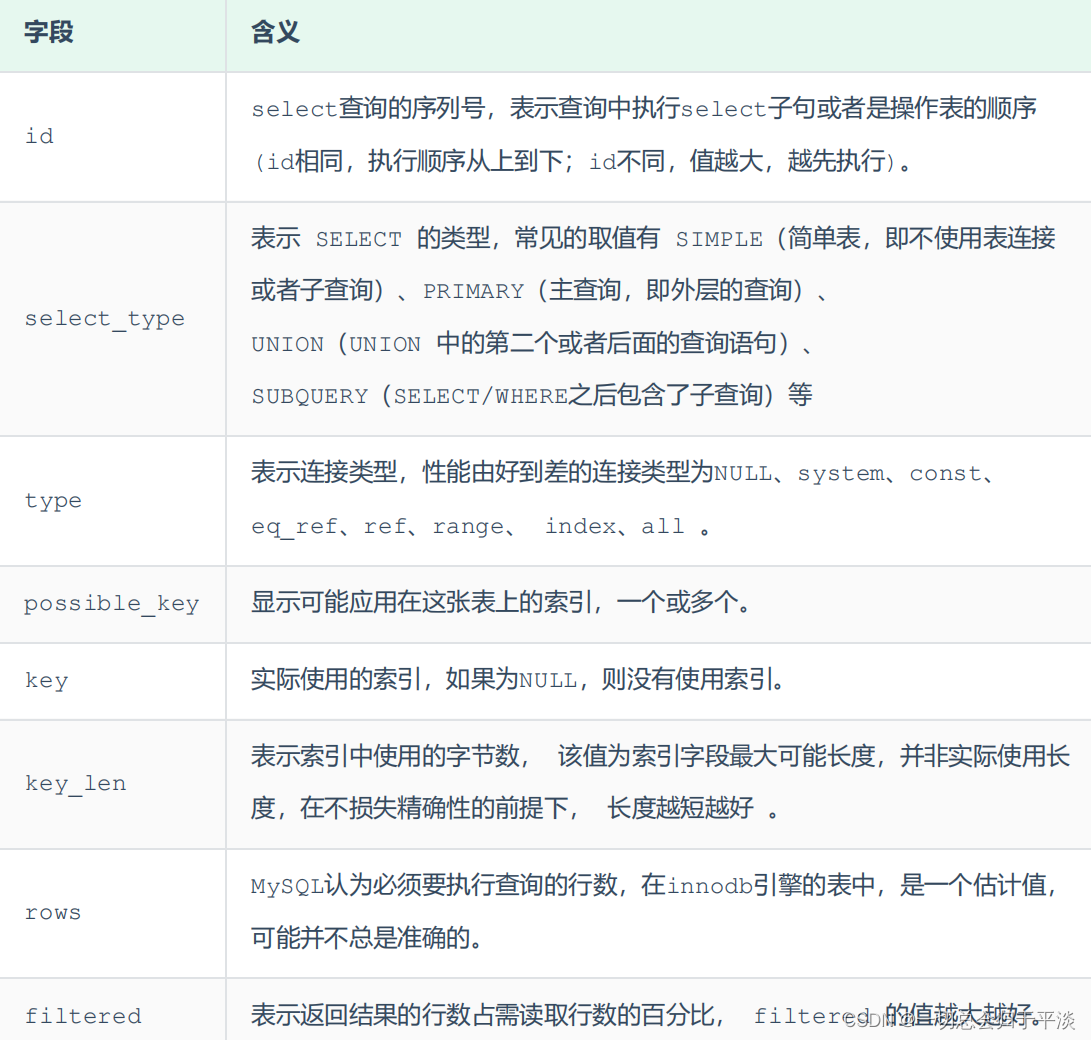
6、 Use of index
6.1 Verify index efficiency
Here is a simple example , I use one with 100w Table of data , Operate on it .
In this list id Primary key , There's a primary key index , Other fields are not indexed . Let's first query one of the records , Look at the fields inside , The implementation is as follows SQL:
select * from tb_sku where id = 50000;
You can see that even if there is 100w The data of , according to id Data query , The performance is still very fast , Because the primary key id It's indexed . So next , Let's go again according to sn Field to query , The implementation is as follows SQL:
SELECT * FROM tb_sku WHERE sn = '1000000031450050000'; 
We can see the basis sn Field to query , The query returned a piece of data , The result is time consuming 13 s 608 ms, Because of sn No index , And the query efficiency is very low .
Then we can aim at sn Field , Build an index , After indexing , We are again based on sn The query , Let's take a look at the query time .
Create index :
create index idx_sku_sn on tb_sku(sn) ;And then do the same again SQL sentence , Look again SQL Time consuming .

We will obviously see ,sn After the field is indexed , Query performance is greatly improved . Before and after indexing , The query time is not an order of magnitude
6.2 The leftmost prefix rule
If you index multiple columns ( Joint index ), Follow the leftmost prefix rule . The leftmost prefix rule means that the query starts from the leftmost column of the index , And don't skip columns in the index . If you jump a column , The index will be partially invalidated ( The following field index is invalid ).
for example , I give t_user Create a federated index on the table ,age,sex,status, If I make a query , The leftmost column age non-existent , Then all indexes are invalid .
And you can't skip a column in the middle , Otherwise, the field index behind the column will be invalidated .
Here's a question to think about :
If I do sql Statement writing , take age and status Exchange positions , Whether the leftmost prefix rule is satisfied at this time ?
answer :
Satisfy , The leftmost column in the leftmost prefix rule , It refers to when querying , The leftmost field of the union index ( This is the first field ) There must be , Write with us SQL when , The order in which conditions are written is irrelevant .
notes :
In the union index , Range query appears (>,<), The column index on the right side of the range query is invalid .
When business allows , Use as much as possible similar to >= or <= This kind of range query , Avoid using > or < .
6.3 Index failure
6.3.1 Index column operation
Do not operate on index columns , Index will fail .
For example, in t_user On the table , The index column is age, If in age use AVG After the function does the average operation , Index failure .
6.3.2 String without quotes
When using string type fields , Without quotes , Index will fail .
Why? ? Because the database has implicit type conversion , Index will fail .
6.3.3 Fuzzy query
If it's just tail blur matching , The index will not fail . If it's a fuzzy head match , Index failure .
When we are making fuzzy query '%1%' , The percent sign cannot be in front of , In this way, the sub index will become invalid ,'1%', Just like this .
6.3.4 or Connection condition
use or The conditions of separation , If or The columns in the previous condition are indexed , And there's no index in the next column , Then the indexes involved will not be used .
select * from tb_user where id = 10 or age = 23;For example, the above statement , If id There is an index , however age No index , At this time, the index will expire , So go ahead or When inquiring , It's best to index both fields .
6.3.5 Data distribution affects
If MySQL Evaluation uses indexes more slowly than full tables , Index is not used .
select * from tb_user where phone >= '17799990005';
select * from tb_user where phone >= '17799990015';For example, the above two statements , But the values passed in are different , The final implementation plan is also completely different , Why? ?
because MySQL In the query , Will evaluate the efficiency of using the index and the efficiency of full table scanning , If you walk the whole table, scanning is faster , Then abandon the index , Take a full scan . Because the index is used to index a small amount of data , If large quantities of data are returned through index query , It's not as fast as scanning the whole table , At this point, the index will be invalidated .
6.4 SQL Tips
SQL Tips , Is an important means to optimize the database , Simply speaking , Is in the SQL Add some human prompts in the statement to optimize the operation .
1、 use index : Suggest MySQL Which index to use to complete this query ( It's just advice ,mysql Internal evaluation will be conducted again ).
explain select * from Table name use index( Index name ) where Conditions 2、 ignore index : Ignore the specified index .
explain select * from Table name ignore index( Index name ) where Conditions 3、force index : Force index .
explain select * from indicate force index( Index name ) where Conditions 6.5 Overlay index
Try to use overlay index , Reduce select *.
So what is an overlay index ? Overlay index refers to the index used in the query , And the columns that need to be returned , All can be found in this index .
This is equivalent to , Our watch has id,age,sex These fields , then id and age They all have indexes .
If we're making a query Use it directly select * , Return all fields , At this time, the back table query will be triggered , What back to table query ?
Originally, if we only returned age, instead of * Number Return all data , This will take the secondary index , To age Field in the secondary index . Found... In the secondary index age The corresponding primary key value , Then return the data .
If the data returned from the query is *, So at this time , You also need to use the primary key value , Find the record corresponding to the primary key value in the clustered index , Finally find Primary key value The corresponding line row.
This requires two index scans , That is, you need to query back to the table , The performance is relatively poor .
In this case, how to optimize ?
That is to add the index to the field without index .
6.6 Prefix index
When the field type is string (varchar,text,longtext etc. ) when , Sometimes you need to index long strings , This makes the index big , When inquiring , Waste a lot of disk IO, Affecting query efficiency .
At this point, you can prefix only part of the string with , build Vertical index , This can greatly save index space , To improve index efficiency .
The grammar is as follows :
create index idx_xxxx on table_name(column(n)) ;Example : by tb_user Tabular email Field , Set the length to 5 Prefix index of .
create index idx_email_5 on tb_user(email(5));Prefix length :
It can be determined according to the selectivity of the index , Selectivity refers to index values that are not repeated ( base ) And the total number of records in the data table , The higher the index selectivity, the higher the query efficiency , The only index selectivity is 1, This is the best index selectivity , Performance is also the best .
select count(distinct email) / count(*) from tb_user ;6.7 Single column index and joint index
-
Single index : That is, an index contains only a single column .
-
Joint index : That is, an index contains multiple columns .
In the business scenario , If there are multiple query criteria , Consider when indexing fields , It is recommended to establish a joint index , Instead of a single column index .
Because if , We use a single column index , A query statement , There are multiple indexes ,MySQL Only one of them , In this way, the rest will certainly go back to the table query and reduce the performance .
7、 Index design principles
For large amount of data , The tables that are frequently queried are indexed .
For often used as query criteria (where)、 Sort (order by)、 grouping (group by) Index the fields of the operation .
Try to select highly differentiated columns as indexes , Try to build a unique index , The more distinguishable , The more efficient the index is .
If it is a string type field , The length of the field is long , You can focus on the characteristics of the field , Building prefix index .
Try to use a federated index , Reduce single column index , When inquiring , Joint indexes can often overwrite indexes , Save storage space , Avoid returning to your watch , Improve query efficiency .
To control the number of indexes , The index is not that more is better , More indexes , The greater the cost of maintaining the index structure , It will affect the efficiency of addition, deletion and modification .
If the index column cannot store NULL value , Please use... When creating the table NOT NULL Constrain it . When the optimizer knows whether each column contains NULL When the value of , It can better determine which index is most effectively used for queries .
版权声明
本文为[Everything will always return to plain]所创,转载请带上原文链接,感谢
https://yzsam.com/2022/04/202204231736239240.html
边栏推荐
- 圆环回原点问题-字节跳动高频题
- EF core in ASP Generate core priority database based on net entity model
- MySQL进阶之索引【分类,性能分析,使用,设计原则】
- [simple understanding of database]
- 快时钟同步慢时钟域下的异步控制信号slow clk to fast clk
- Using quartz under. Net core -- general properties and priority of triggers for [5] jobs and triggers
- 48. 旋转图像
- Allowed latency and side output
- 394. 字符串解码-辅助栈
- Halo 开源项目学习(二):实体类与数据表
猜你喜欢

Collection of common SQL statements
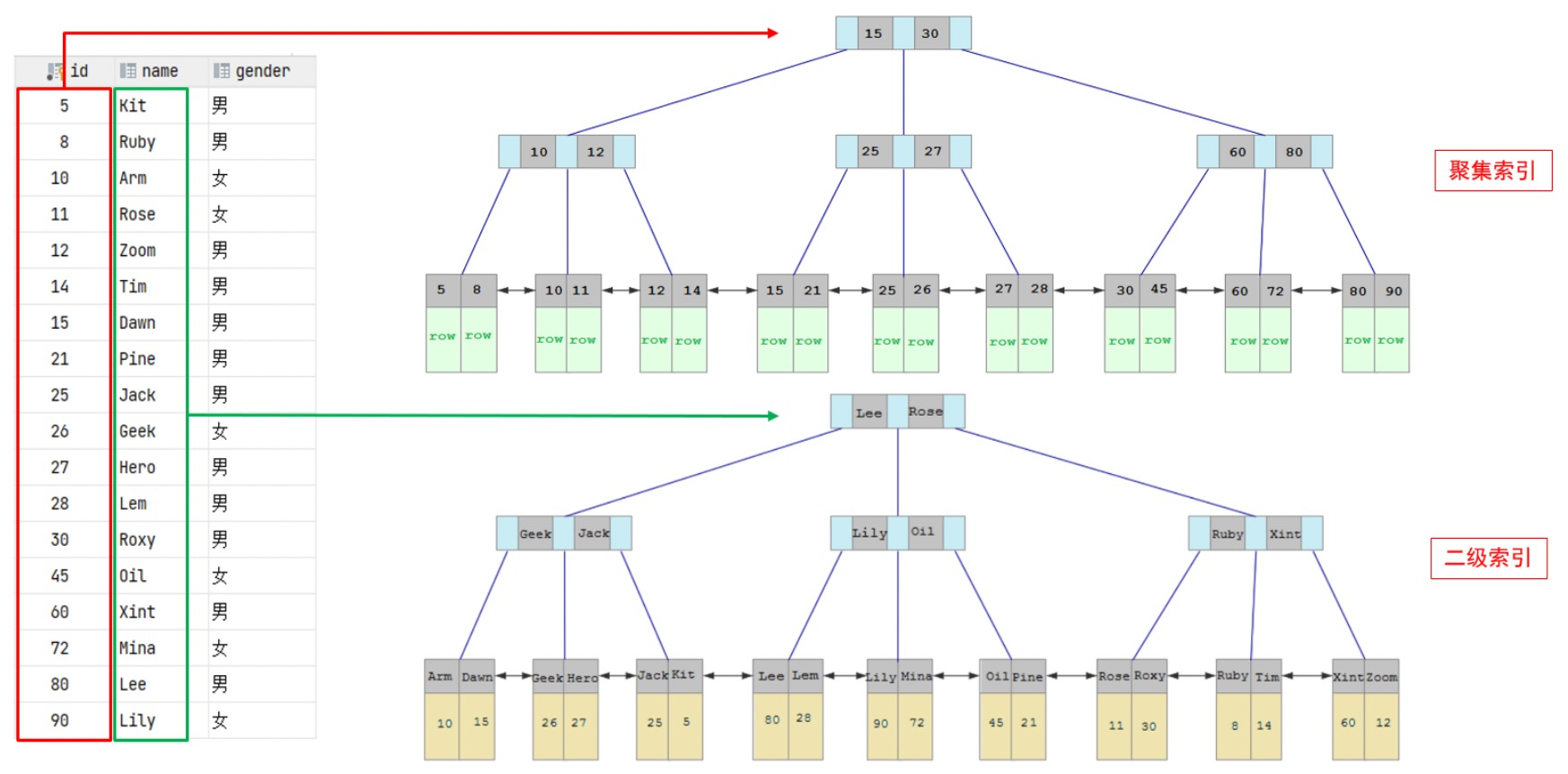
索引:手把手教你索引从零基础到精通使用
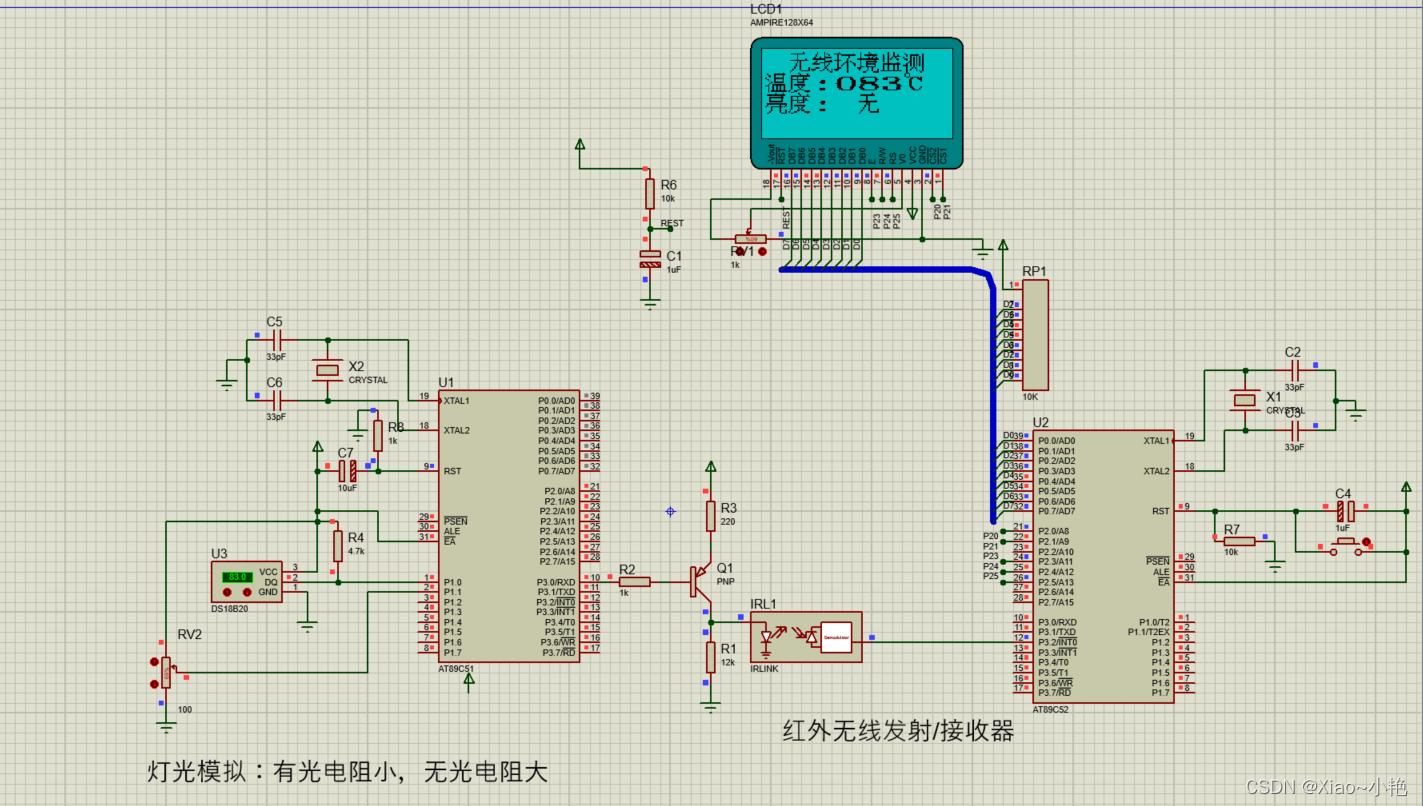
基于51单片机红外无线通讯仿真

Signalr can actively send data from the server to the client
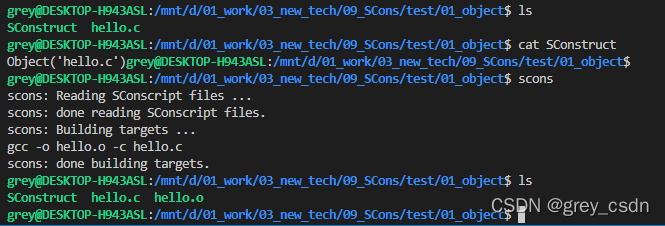
1217_使用SCons生成目标文件

Detailed explanation of C webpai route

双闭环直流调速系统matlab/simulink仿真
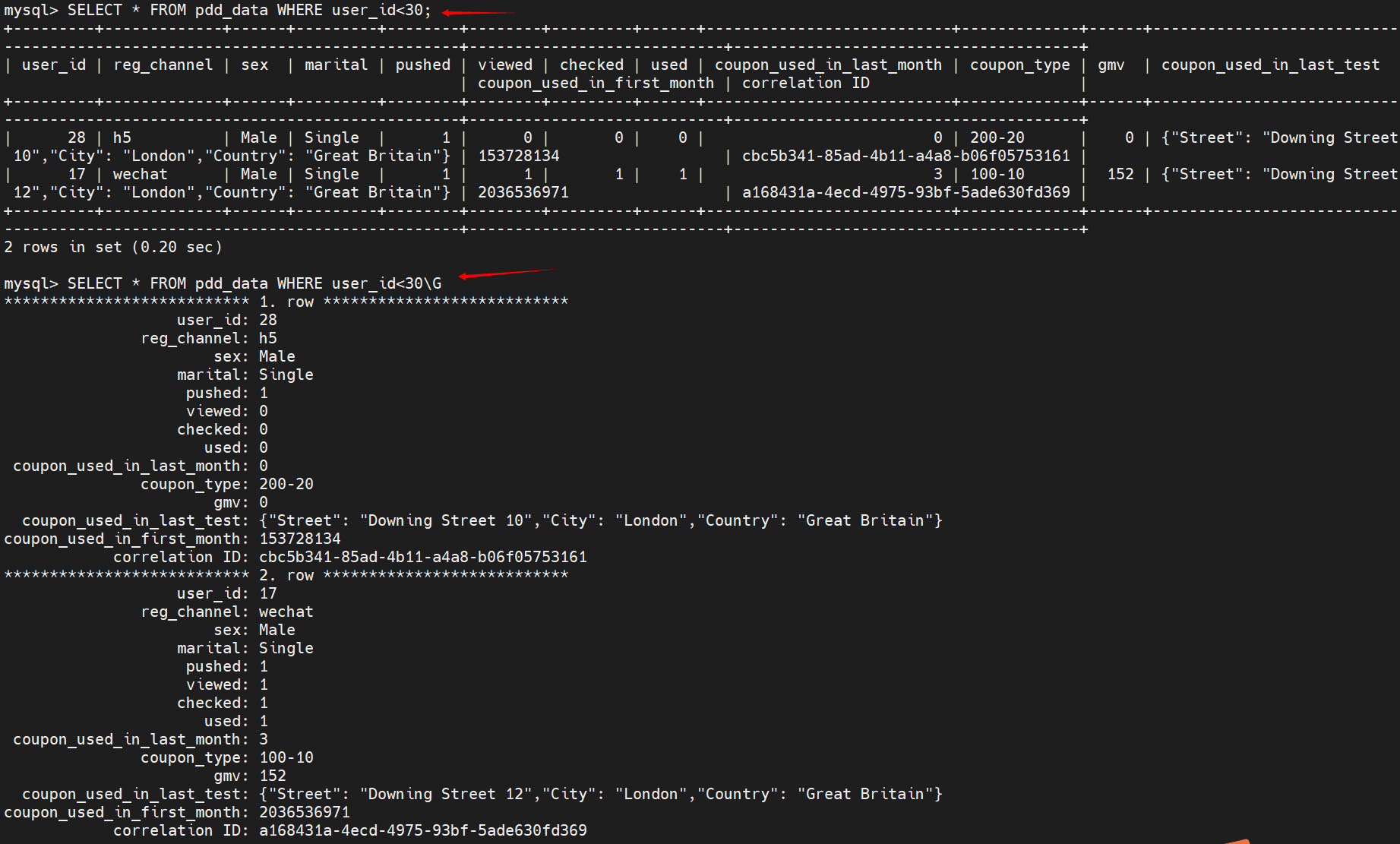
Summary of common SQL statements

MySQL进阶之索引【分类,性能分析,使用,设计原则】

Qt error: /usr/bin/ld: cannot find -lGL: No such file or directory
随机推荐
In embedded system, must the program code in flash be moved to ram to run?
Perception of linear algebra 2
uni-app黑马优购项目学习记录(下)
tidb-server 的配置文件在哪里?
How to change input into text
Model problems of stock in and stock out and inventory system
ClickHouse-数据类型
基于51单片机红外无线通讯仿真
Open futures, open an account, cloud security or trust the software of futures companies?
Shell-sed命令的使用
stm32入门开发板选野火还是正点原子呢?
開期貨,開戶雲安全還是相信期貨公司的軟件?
圆环回原点问题-字节跳动高频题
402. 移掉 K 位数字-贪心
2.Electron之HelloWorld
Using quartz under. Net core -- a simple trigger of [7] operation and trigger
Simulation of infrared wireless communication based on 51 single chip microcomputer
[difference between Oracle and MySQL]
Understanding of RPC core concepts
超分之TDAN